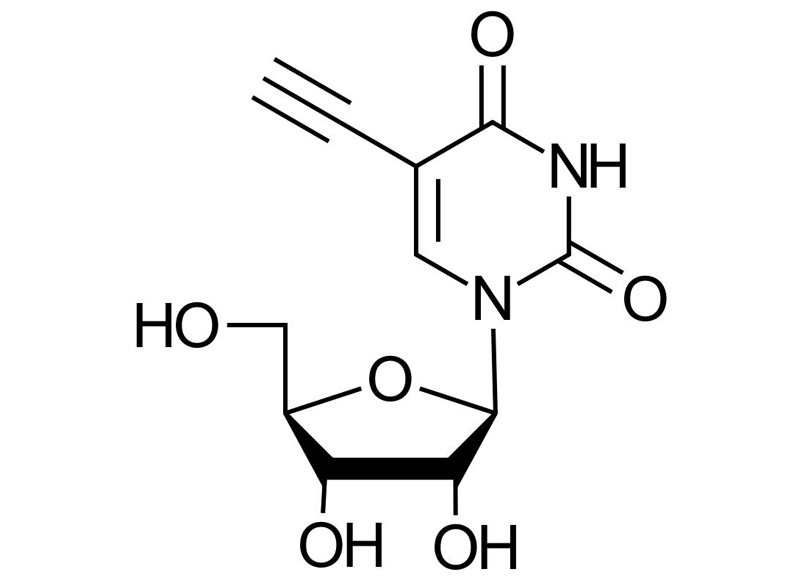5-Ethynyl uridine (5-EU)
Clickable EU allows detection of de novo RNA

| Size | Catalog No. | Price |
|---|---|---|
| 10 mg | BCN-003-10 | € 65,00 |
| 100 mg | BCN-003-100 | € 400,00 |
Chemical Properties
-
Molecular Formula
C11H12N2O6
-
Shelf Life
12 months unopened after receipt
-
Storage Conditions
-20 °C, dry, inert gas
-
Molecular Weight
268.22 g/mol
-
Purity
≥ 98% (HPLC)
-
Physical State
white to light brown to light green powder
-
CAS Number
69075-42-9
-
Additional name
EU, 1-((2R,3R,4S,5R)-3,4-dihydroxy-5-(hydroxymethyl)tetrahydrofuran-2-yl)-5-ethynylpyrimidine-2,4(1H,3H)-dione
-
Solubility
water, aqueous buffer, DMSO, ethanol
Product Information
Sensitive Labeling of Nascent RNA without a Denaturation
5-EU is a uridine analogue widely used for visualizing global nascent RNA transcription in vitro and in vivo.[1] Once incorporated into RNA at nascent transcription sites within a cell, the RNA can be fluorescently labeled without denaturation using the copper-catalyzed azide–alkyne cycloaddition (CuAAC) reaction labelled as ‘click’ chemistry.[2, 3] This highly efficient method provides clear signals for microscopy, flow cytometry and high-content screening, and is faster and gentler than BrU-based assays.

Why buy 5-EU from baseclick?
- Market‑leading pricing with bulk options, consistent ≥ 98% HPLC purity, and rapid, reliable supply for research and development.
- Available Sizes: 10 mg, 100 mg, and bulk quantities upon request (research use only; not for diagnostic procedures).
What makes 5-EU different from other options?
- Click chemistry-based detection: Rapid, efficient dye conjugation to the ethynyl handle, recognized in the 2022 Nobel Prize in Chemistry, [2, 3] for high sensitivity and clean backgrounds.[1]
- No RNA denaturation required: Preserves cell morphology and antigenicity—ideal for multiplexing with immunostaining.
- High signal‑to‑noise ratio: Strong, uniform fluorescence signals for robust detection and imaging.
- Broad compatibility: Works seamlessly with mammalian cells, organoids, and tissue sections; supports in vitro and in vivo research workflows.
How does 5-ethynyl uridine (5-EU) work?
Cell‑permeable 5‑EU is converted intracellularly to the triphosphate and incorporated into newly synthesized RNA, replacing uridine. The ethynyl group then reacts with azide‑modified tags as e.g. fluorophores via CuAAC, generating bright labeling that marks nascent RNA with high specificity and spatial resolution.

Can 5-EU be used to generate functionalized mRNAs?
5-EU is well-suited to generate internally functionalized RNAs using mild and efficient click chemistry. Its ethynyl group allows for conjugation with azide‑modified moieties like fluorescent dyes, biotins, linkers or other tags.
EU-modified mRNA can be synthesized easily by replacing uridine triphosphate (UTP) by 5-EUTP in an in vitro transcription (IVT) [4]. For this purpose, we recommend using the baseScribe T7 High Yield IVT Kits, which are designed for fast and robust mRNA synthesis with excellent yield.
LITERATURE
- Exploring RNA transcription and turnover in vivo by using click chemistry. C.Y. Jao, A. Salic, 2008, Proc. Natl. Acad. Sci, Vol. 105(41), p. 15779-15784.
- Peptidotriazoles on Solid Phase: [1,2,3]-Triazoles by Regiospecific Copper(I)-Catalyzed 1,3-Dipolar Cycloadditions of Terminal Alkynes to Azides. C. W. Tornøe, C. Christensen, M. Meldal, 2002, J. Org. Chem., Vol. 67, p. 3057-3064.
- A Stepwise Huisgen Cycloaddition Process: Copper(I)-Catalyzed Regioselective “Ligation” of Azides and Terminal Alkynes. V. V. Rostovtsev, L. G. Green, V. V. Fokin, K. B. Sharpless, 2002, Angew. Chemie Int. Ed., Vol. 41, p. 2596–2599.
- 5-Ethynyluridine: A Bio-orthogonal Uridine Variant for mRNA-Based Therapies and Vaccines. S. Maassen, B. Coenen, S.-L. Dülk, M. van der Werff, H. Warner, F. Spada, T. Frischmuth, D. Incarnato, G. van den Bogaart, 2023, ChemBioChem, Vol. 24, e202200658. https://doi.org/10.1038/nmeth.4595
- Visualization of the Nucleolus Using Ethynyl Uridine, M. Dvořáčková et al., 2018, Frontiers in Plant Science, Vol. 9(177). https://doi.org/10.3389/fpls.2018.00177
FAQ
-
Why is EU better than BrU?
EU detection is antibody‑free and does not require RNA denaturation, preserving epitopes for co‑staining and delivering faster, cleaner readouts.
-
Which readouts are supported?
Fluorescence microscopy, flow cytometry, high‑content imaging; compatible with multiplex immunostaining.
-
Is EU toxic?
At commonly used concentrations and pulse times, EU is well‑tolerated in standard cell systems. Evaluate for your model and endpoint.

